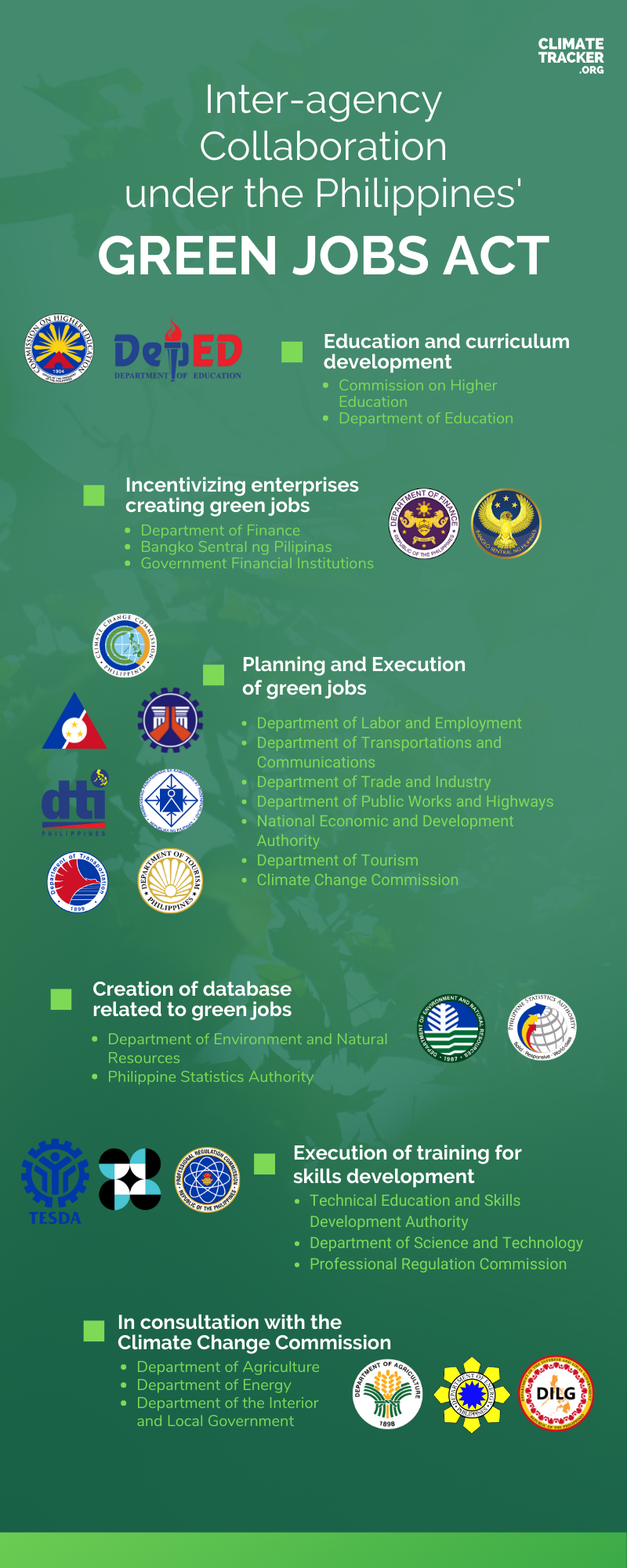
WHEN ANNE Parojinog first entered college as an Environmental Biology student at the University of Santo Tomas (UST) in Manila, she was unsure of the path to take once she finishes her degree. But after leaving the university, she is now determined to pursue what she called an unconventional career path—to become an environmental biologist and researcher.
For Parojinog, becoming a scientist can make a difference especially because not too many people are taking the same path.
She believes that her future research undertakings would not simply be confined to academic journals; she can also offer these studies to aid policymakers. Parojinog, however, sees that the country might not produce enough green jobs—or those that contribute to preserving or restoring the environment—in the years to come.
“In terms of economics, we prioritize the increase of our [gross domestic products] and higher-salary jobs more,” Parojinog said. “So I think that although there are a lot of people interested in working in the field and are passionate about [it], we still have this dilemma about what to choose.”
Studying Environmental Biology 1,467 kilometers away from the Philippine borders, James Edward Dizon has yet to fully decide on what to do after college. But the student from Thai Nguyen University of Agriculture and Forestry in Vietnam is hopeful that he would get a job related to environmental protection in his home country.
“That would be better if I land a [green job] in the country because that would mean I could contribute easily,” Dizon said.
According to a recent study by Accenture, 77% of the 29,500 youth aged 15 to 39 in the Asia Pacific said that they wanted to work in a green economy in the next decade.
“The region’s youth are especially enthusiastic about making a positive environmental impact and working for organizations that demonstrate a real commitment to sustainability,” Gianfranco Casati, Accenture’s CEO for Growth Markets, said in the study.
However, the Philippines faces several challenges in the generation of green jobs such as a lack of social safety nets, difficulty in the transition due to high capital costs and limited access to technology, and people’s lack of awareness on climate change despite having laws that enable industries to produce green jobs for transition into a more sustainable economy.
Green jobs
On April 29, 2016, former president Benigno ‘Noynoy’ Aquino III signed into law the Green Jobs Act, which seeks to incentivize individuals and business enterprises that will help create a green economy.
Green jobs, as defined by the law, refer to employment that helps “protect ecosystems and biodiversity, reduce energy, materials and water consumption through high-efficiency strategies, decarbonize the economy, and minimize or altogether avoid the generation ration of all forms of waste and pollution.”
To assist in the execution of the said measure, 20 inter-agency bodies are directed to help different industries in shifting towards a greener economy.

In his 2019 paper about job transition in the country, Wilson Fortaleza of Partido Manggagawa said that the Green Jobs Act is a product of the initiatives of the International Labor Organization (ILO) and the Department of Labor and Employment (DOLE) for sustainable decent work.
“Most activities…such as the tripartite consultations, inter-agency coordination, and capacity building meetings as well as other mainstreaming initiatives have already been conducted or at their different levels of implementation in their respective government agencies,” Fortaleza noted in his paper.
He added that a “checklist for what was already done” would have helped but the concerned bodies have not been able to provide this.
Present but limited
According to ILO’s green jobs mapping in 2014 before the law was signed, these types of jobs existed in formal and informal sectors. However, there is no labor market information on the available green jobs in the country even if some public and private sectors have promoted it.
Fortaleza emphasized that there is a lack of projects that generate green employment and it can be seen in the lack of sustainable transition from big companies in the shipping, power, transportation, and agriculture industries.
“If there are projects, the demand for skilled workers would rise. But if there is a slow generation of green jobs, where would skilled workers go?” Fortaleza said.
Prof. Jazztin Jairum Manalo, who teaches environmental policies at UST, said that a lot of people in different industries do not know that what they are doing is already a green job.
He explained that this type of green employment is not just limited to the hard sciences as it could range from people whose livelihood is planting to those whose job is teaching sustainable development as long as the work promotes awareness towards environmental conservation.
“What I notice is that green jobs, even before, are already present. It was just strengthened by the Green Jobs Act and the Sustainable Development Goals,” Manalo said. “Now, if these jobs are present, the question is how the government will be able to tap these green livelihoods efficiently.”
What went wrong?
The aims of the Green Jobs Act are good, but there were lapses in the implementation because the law’s intended outcomes do not reflect the reality on the ground, Manalo and Fortaleza stressed.
“The law is not the problem. The problem is that we do not have effective leadership,” Fortaleza said, adding that the projects of different inter-agencies to supposedly generate green jobs are slow-moving.
“It’s good that we are the only country in Asia who has a Green Jobs Act. However, in the production of renewable energy and green jobs, we’re not number one,” he added.
Georgina Pascual, national project coordinator of ILO Philippines’ InSIGHT2 project, said that the apparent “lull” in the implementation of the measure can be traced to the lack of specific guidelines on how incentives can be granted and how companies can apply for those. She stressed that the law will only become relevant if the concerned agencies would be able to fix these.
“The biggest expectation from the law is that it can provide incentives and it seems like without that, the noise is just a pronouncement,” Pascual said. However, she noted that the ILO and the World Bank have recently supported Climate Change Commission’s (CCC) input as one of the 20 inter-agency bodies who has a role in the implementation of the Green Jobs Act.
Pascual underscored that CCC should put in place an assessment process that would eventually indicate whether a company is producing green jobs. She added that other executive agencies like DOLE and Technical Education and Skills Development Authority (TESDA) have been continuing their individual efforts without “necessarily carrying the banner of green jobs as indicated in the law.”
In 2018, TESDA, along with ILO, hosted a forum to facilitate the greening of the country’s technical-vocational education. In the forum, they presented to their stakeholders the concept of a “greener” technical-vocational education and training (TVET) and to produce inputs for strategic planning for greener technical-vocational education.
According to a 2021 report by Institute for Labor Studies, TESDA has reportedly approved 24 training regulations (TR). A TR is a document that defines the competency standards for a national qualification on a certain work.
However, based on TESDA’s national technical education and skills development plan for 2018 to 2022, the agency has a total of 264 TRs.
For Manalo, the country could produce additional green employment by partnering with the private sector.
“The problem is that, it still depends whether the person’s interest within environmental conservation, climate change, and sustainable development is within the type of green jobs available in the country,” said Manalo, noting the country should look for the right people for the right green jobs.
No other choice?
Students Parojinog and Dizon are worried about the possibility of not landing a green job so both are looking at the option of going abroad to further their studies with the hopes of getting a job in the Philippines.
“In terms of alternatives, you can also be an instructor in the field,” Parojinog said, adding that being a teacher is not less of a profession because it is also a means to communicate their learnings through education.
“There are a lot of opportunities abroad but at the end of the day, we will always go back to our people and environment in the Philippines.”
While the future of green jobs remains dim for Dizon, he is hoping it would improve because “it could really help a lot of people.”
For Pascual, young people aiming to land green jobs should look at the rising interest in green architecture, energy, and mobility because these industries slowly adapt to more sustainable work. Pascual also noted the importance of looking at whether there is available training to prepare students for their desired jobs.
“There are definitely occupations that can be referred to as green jobs,” Pascual said. “What is crucial is what it would take for anyone to go there.” F
This story was supported by Climate Tracker.




[…] story was originally published on The Flame, through our Just Transition Journalism Fellowship, in partnership with Friedrich […]
[…] Originally published on The Flame […]
[…] They wrote about the concerns of students who want to land green jobs after graduation, and published the stories in their university publications such as the University of Santo Tomas, The Flame, and De La Salle […]
[…] story was originally published on The Flame, through our Just Transition Journalism Fellowship, in partnership with Friedrich […]